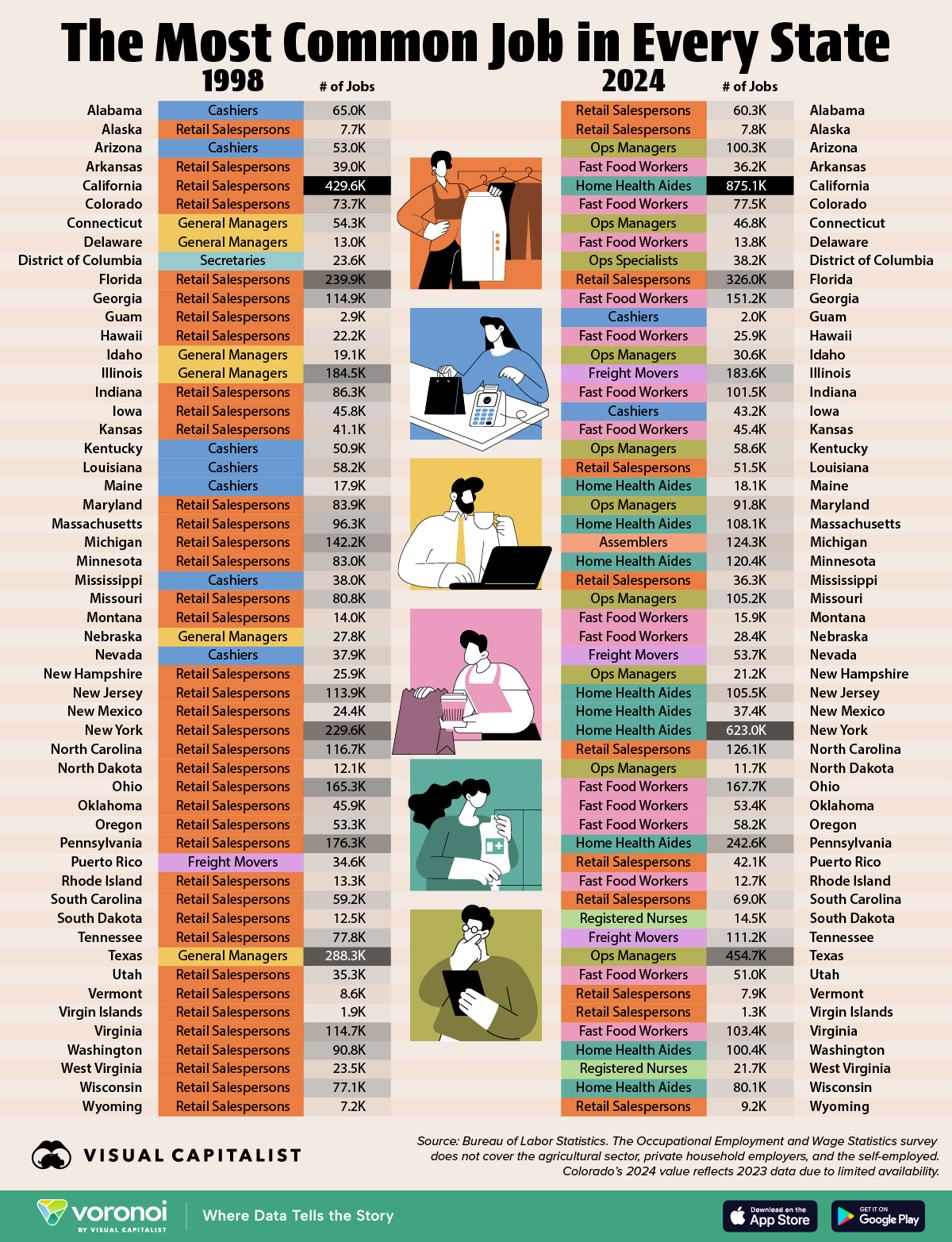Visualized: Every State’s Most Common Job in 1998 vs. 2024
This was originally posted on our Voronoi app. Download the app for free on iOS or Android and discover incredible data-driven charts from a variety of trusted sources.
Key Takeaways
- Retail salesperson (39 states) and cashiers (7) were the most common job categories by state back in 1998.
- In 2024, it’s fast food worker (15 states) and retail salesperson (11).
- Home health aides are a new popular job category, the most common in 10 states.
1998 was a long time ago.
The first Matrix movie hadn’t yet released, the internet was still the purview of the Western world, and e-commerce giant Amazon was only five years old.
For obvious reasons, the U.S. labor market back then was different—but exactly how different?
This graphic compares the most common jobs in each U.S. state between 1998 to 2024, measured by the number of people employed in each category. Data for this visualization comes from the Bureau of Labor Statistics.
 Only the largest job category was chosen for each state, and several categories came within close ties of each other. Furthermore, the source does not collect estimates for the agriculture sector.
Only the largest job category was chosen for each state, and several categories came within close ties of each other. Furthermore, the source does not collect estimates for the agriculture sector.America’s Most Common Jobs in 1998, Listed
In 1998, retail salespersons were the most common job in 39 states.
Cashiers took the top spot in seven others, showing the strength of consumer-facing roles during a booming retail era.
| State | Most Common Job (1998) |
# of Jobs (1998) |
Most Common Job (2024) |
# of Jobs (2024) |
|---|---|---|---|---|
| Alabama |  Cashiers Cashiers |
64,990 |  Retail Salespersons Retail Salespersons |
60,330 |
| Alaska |  Retail Salespersons Retail Salespersons |
7,650 |  Retail Salespersons Retail Salespersons |
7,790 |
| Arizona |  Cashiers Cashiers |
52,950 |  Ops Managers Ops Managers |
100,340 |
| Arkansas |  Retail Salespersons Retail Salespersons |
38,950 |  Fast Food Workers Fast Food Workers |
36,150 |
| California |  Retail Salespersons Retail Salespersons |
429,600 |  Home Health Aides Home Health Aides |
875,110 |
| Colorado |  Retail Salespersons Retail Salespersons |
73,680 |  Fast Food Workers Fast Food Workers |
77,500 |
| Connecticut |  General Managers General Managers |
54,300 |  Ops Managers Ops Managers |
46,780 |
| Delaware |  General Managers General Managers |
12,950 |  Fast Food Workers Fast Food Workers |
13,800 |
| District of Columbia |  Secretaries Secretaries |
23,590 |  Ops Specialists Ops Specialists |
38,240 |
| Florida |  Retail Salespersons Retail Salespersons |
239,940 |  Retail Salespersons Retail Salespersons |
325,960 |
| Georgia |  Retail Salespersons Retail Salespersons |
114,920 |  Fast Food Workers Fast Food Workers |
151,240 |
| Guam |  Retail Salespersons Retail Salespersons |
2,860 |  Cashiers Cashiers |
1,960 |
| Hawaii |  Retail Salespersons Retail Salespersons |
22,180 |  Fast Food Workers Fast Food Workers |
25,850 |
| Idaho |  General Managers General Managers |
19,130 |  Ops Managers Ops Managers |
30,600 |
| Illinois |  General Managers General Managers |
184,490 |  Freight Movers Freight Movers |
183,590 |
| Indiana |  Retail Salespersons Retail Salespersons |
86,310 |  Fast Food Workers Fast Food Workers |
101,500 |
| Iowa |  Retail Salespersons Retail Salespersons |
45,820 |  Cashiers Cashiers |
43,160 |
| Kansas |  Retail Salespersons Retail Salespersons |
41,070 |  Fast Food Workers Fast Food Workers |
45,420 |
| Kentucky |  Cashiers Cashiers |
50,910 |  Ops Managers Ops Managers |
58,570 |
| Louisiana |  Cashiers Cashiers |
58,180 |  Retail Salespersons Retail Salespersons |
51,540 |
| Maine |  Cashiers Cashiers |
17,910 |  Home Health Aides Home Health Aides |
18,080 |
| Maryland |  Retail Salespersons Retail Salespersons |
83,900 |  Ops Managers Ops Managers |
91,810 |
| Massachusetts |  Retail Salespersons Retail Salespersons |
96,300 |  Home Health Aides Home Health Aides |
108,090 |
| Michigan |  Retail Salespersons Retail Salespersons |
142,220 |  Assemblers Assemblers |
124,340 |
| Minnesota |  Retail Salespersons Retail Salespersons |
83,040 |  Home Health Aides Home Health Aides |
120,390 |
| Mississippi |  Cashiers Cashiers |
38,030 |  Retail Salespersons Retail Salespersons |
36,330 |
| Missouri |  Retail Salespersons Retail Salespersons |
80,770 |  Ops Managers Ops Managers |
105,210 |
| Montana |  Retail Salespersons Retail Salespersons |
13,960 |  Fast Food Workers Fast Food Workers |
15,940 |
| Nebraska |  General Managers General Managers |
27,760 |  Fast Food Workers Fast Food Workers |
28,360 |
| Nevada |  Cashiers Cashiers |
37,890 |  Freight Movers Freight Movers |
53,660 |
| New Hampshire |  Retail Salespersons Retail Salespersons |
25,940 |  Ops Managers Ops Managers |
21,180 |
| New Jersey |  Retail Salespersons Retail Salespersons |
113,890 |  Home Health Aides Home Health Aides |
105,460 |
| New Mexico |  Retail Salespersons Retail Salespersons |
24,370 |  Home Health Aides Home Health Aides |
37,360 |
| New York |  Retail Salespersons Retail Salespersons |
229,620 |  Home Health Aides Home Health Aides |
623,000 |
| North Carolina |  Retail Salespersons Retail Salespersons |
116,680 |  Retail Salespersons Retail Salespersons |
126,060 |
| North Dakota |  Retail Salespersons Retail Salespersons |
12,140 |  Ops Managers Ops Managers |
11,660 |
| Ohio |  Retail Salespersons Retail Salespersons |
165,290 |  Fast Food Workers Fast Food Workers |
167,650 |
| Oklahoma |  Retail Salespersons Retail Salespersons |
45,860 |  Fast Food Workers Fast Food Workers |
53,380 |
| Oregon |  Retail Salespersons Retail Salespersons |
53,300 |  Fast Food Workers Fast Food Workers |
58,150 |
| Pennsylvania |  Retail Salespersons Retail Salespersons |
176,330 |  Home Health Aides Home Health Aides |
242,570 |
| Puerto Rico |  Freight Movers Freight Movers |
34,560 |  Retail Salespersons Retail Salespersons |
42,070 |
| Rhode Island |  Retail Salespersons Retail Salespersons |
13,340 |  Fast Food Workers Fast Food Workers |
12,650 |
| South Carolina |  Retail Salespersons Retail Salespersons |
59,230 |  Retail Salespersons Retail Salespersons |
69,010 |
| South Dakota |  Retail Salespersons Retail Salespersons |
12,480 |  Registered Nurses Registered Nurses |
14,500 |
| Tennessee |  Retail Salespersons Retail Salespersons |
77,760 |  Freight Movers Freight Movers |
111,240 |
| Texas |  General Managers General Managers |
288,290 |  Ops Managers Ops Managers |
454,720 |
| Utah |  Retail Salespersons Retail Salespersons |
35,310 |  Fast Food Workers Fast Food Workers |
50,980 |
| Vermont |  Retail Salespersons Retail Salespersons |
8,630 |  Retail Salespersons Retail Salespersons |
7,930 |
| Virgin Islands |  Retail Salespersons Retail Salespersons |
1,860 |  Retail Salespersons Retail Salespersons |
1,310 |
| Virginia |  Retail Salespersons Retail Salespersons |
114,740 |  Fast Food Workers Fast Food Workers |
103,390 |
| Washington |  Retail Salespersons Retail Salespersons |
90,760 |  Home Health Aides Home Health Aides |
100,360 |
| West Virginia |  Retail Salespersons Retail Salespersons |
23,450 |  Registered Nurses Registered Nurses |
21,740 |
| Wisconsin |  Retail Salespersons Retail Salespersons |
77,080 |  Home Health Aides Home Health Aides |
80,050 |
| Wyoming |  Retail Salespersons Retail Salespersons |
7,170 |  Retail Salespersons Retail Salespersons |
9,190 |
Note: D.C., Guam, Puerto Rico, and the Virgin Islands have been included in this graphic and article. They have been referred to as states for general trend analysis.
The data reflects a time when brick-and-mortar stores and administrative support jobs were critical to state economies.
America’s Most Common Jobs in 2024, Listed
By 2024, fast food workers became the most common job in 15 states, overtaking retail in sheer prevalence.
This rise aligns with the growth of quick-service restaurants and a broader shift toward lower-wage, flexible service jobs.
Retail salespersons remain the top job in 11 states, while operations managers, home health aides, and freight movers have gained ground in several others.
Healthcare and Logistics Jobs in the 2020s
Notably, home health aides became the most common job in five states, including California and New York.
This highlights the aging U.S. population and rising demand for elder care services.
Meanwhile, freight movers and operations managers now top the charts in states like Illinois, Tennessee, and Texas. This signals that retail is still a strong sector, but the jobs have moved towards logistics and supply chain roles as in-person buying drops.
Learn More on the Voronoi App 
These healthcare jobs are possibly the safest in an AI world. Check out Ranked: The Fastest Growing Jobs in the U.S. (2023-2033F) on Voronoi, the new app from Visual Capitalist.

